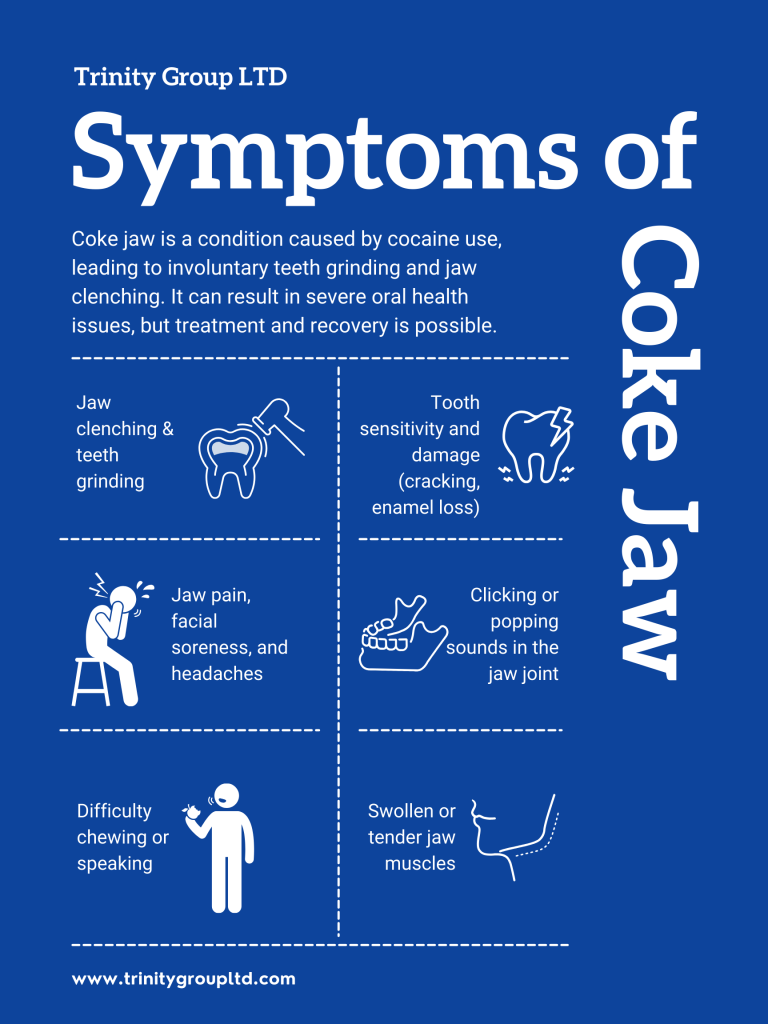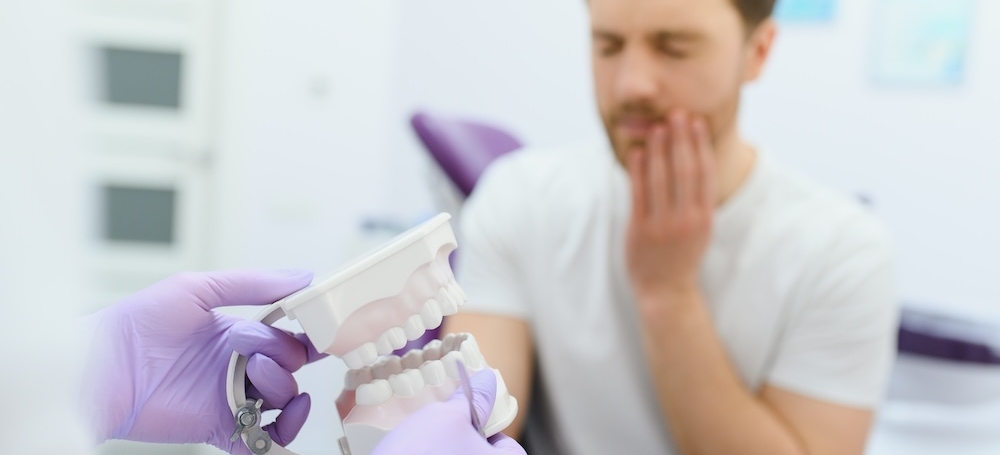Coke jaw, or cocaine jaw, refers to a set of symptoms often experienced by cocaine users, including involuntary teeth grinding, intense jaw clenching, and repetitive facial movements. These behaviors stem from cocaine’s powerful impact on the central nervous system, which ramps up muscle activity, particularly around the jaw. Left unchecked, coke jaw can lead to serious oral health issues, such as worn-down teeth, aching facial muscles, and even damage to the jaw joints.
In this article, we’ll explore what coke jaw is, how cocaine affects oral health, and the key signs and symptoms to watch for. We’ll also explore the potential long-term impacts and how to find help if you’re grappling with cocaine addiction.
Cocaine’s Effects on Oral Health
Cocaine, a stimulant derived from the coca plant, produces euphoria, increased energy, and heightened focus. However, it also impacts muscle control and constricts blood vessels, leading to numerous side effects in the mouth, teeth, and jaw. When a person uses cocaine, especially over a long period, the drug overstimulates the muscles in the jaw, causing involuntary movements such as clenching and grinding. Known as bruxism, this repetitive action places extreme stress on the jaw and teeth.

How Cocaine Use Leads to Coke Jaw
Several factors contribute to the development of coke jaw:
- Muscle hyperactivity: Cocaine increases neurotransmitters like dopamine and norepinephrine, stimulating muscle activity, including jaw muscles.
- Reduced blood flow: Constricted blood vessels reduce blood flow to gums and other oral tissues, slowing healing and increasing susceptibility to infections.
- Dry mouth: Cocaine can decrease saliva production, leading to dry mouth (xerostomia). This condition reduces the mouth’s natural defense against bacteria, raising the risk of tooth decay and gum disease.
Recognizing the Signs and Symptoms of Coke Jaw

For someone concerned about coke jaw, specific symptoms can indicate its presence. These symptoms may start subtly but become more severe with prolonged cocaine use:
1. Jaw Clenching and Teeth-Grinding
One of the most common signs of coke jaw is frequent, involuntary clenching of the jaw and grinding of the teeth, known as bruxism. This grinding can occur during or after cocaine use, often without the individual even realizing it. Over time, these repeated actions place extreme pressure on the teeth, leading to gradual wear and damage.
2. Tooth Damage
The constant grinding wears down tooth enamel, a protective outer layer for teeth. When enamel erodes, teeth become more vulnerable to sensitivity, cavities, and cracking or chipping. In severe cases, individuals may experience loose teeth or require dental restoration to repair the extensive damage caused by coke jaw.
3. Facial and Jaw Pain
Chronic tension in the jaw muscles often leads to soreness and discomfort in the jaw, face, and neck. Individuals with coke jaw may notice frequent headaches, particularly in the morning, due to overnight grinding. This pain can become constant and significantly impact daily activities.
4. Difficulty Chewing or Speaking
In advanced cases, the strain on jaw muscles can interfere with essential functions such as chewing and speaking. The jaw may become stiff, and simple movements like opening or closing the mouth can be challenging or painful, affecting the overall quality of life.
5. Jaw Joint Issues
People with coke jaw may notice clicking or popping sounds in the joint, indicating potential damage to the temporomandibular joint (TMJ). These symptoms can lead to chronic pain and limit the jaw’s range of motion, making everyday activities uncomfortable.
Long-Term Consequences of Coke Jaw

Coke jaw can have serious, lasting effects on oral health and overall well-being. The extended stress and strain from coke jaw contribute to:
1. Permanent Tooth Damage
Repeated grinding and clenching can cause permanent damage to teeth, including cracks, chips, and looseness. When enamel is worn down, teeth become highly susceptible to decay and may eventually require crowns, fillings, or extractions. Left untreated, this damage can significantly impact oral health and appearance.
2. Gum Disease
The combination of decreased blood flow and dry mouth due to cocaine use creates an environment where bacteria can easily multiply, increasing the risk of gum disease. If untreated, gum disease can lead to periodontal issues, which can cause tooth loss and require extensive treatment to manage and reverse.
3. Jaw Disorders
Constant strain on the jaw muscles and joints can lead to temporomandibular joint disorder (TMD), a condition that affects the function and movement of the jaw. TMD can result in chronic jaw pain, limited movement, and severe discomfort, particularly during activities such as eating and speaking. Treating TMD often requires specialized care, and symptoms may persist even after cocaine use has stopped.
4. Facial Changes
Coke jaw may lead to noticeable changes in facial appearance. Due to muscle overuse and possible tooth loss, some individuals develop a more prominent or altered jawline. Over time, these changes can impact self-esteem and require surgical or dental intervention to correct.
Cocaine Addiction and Its Physical and Psychological Effects
Cocaine addiction goes beyond physical symptoms like coke jaw—it affects nearly every aspect of a person’s life, from physical health to emotional well-being and relationships. Here’s how:
1. Physical Strain and Increased Tolerance
Over time, regular cocaine use can push the body to its limits. The stimulant effects of the drug lead to increased tolerance, meaning individuals need more of it to experience the same high. This escalates the risk of health complications, including overdose.
2. Disrupted Responsibilities and Relationships
Cocaine addiction often interferes with daily life. Individuals may start neglecting essential responsibilities, avoiding obligations, and struggling to maintain relationships. Self-care becomes challenging, leading to personal, social, and professional life declines.
3. Risky Behaviors
Addiction can drive individuals to take impulsive actions—like overspending or obtaining cocaine from unsafe sources. These behaviors impact financial stability and increase exposure to harmful or dangerous situations.
4. Emotional Withdrawal Symptoms
When someone tries to reduce or quit cocaine, they may experience withdrawal symptoms like fatigue, depression, and irritability. These symptoms can make it hard to stay motivated in recovery, often creating a cycle of relapse.
Without support and treatment, the effects of cocaine addiction can grow, impacting not just the individual but also their loved ones. Recognizing the wide-reaching impacts of addiction is the first step toward meaningful recovery.
Treatment for Cocaine Addiction and Coke Jaw
Recovering from cocaine addiction requires comprehensive care that addresses both physical symptoms like coke jaw and the underlying psychological aspects of substance abuse.

Treatment options include:
1. Cocaine Detox
Detoxification is the initial step to help the body eliminate cocaine. This stage typically involves managing withdrawal symptoms like intense cravings, depression, fatigue, and agitation. Medical detox centers provide a safe environment where professionals can monitor the individual’s health and offer support throughout the process.
2. Behavioral Therapy
Behavioral therapies like cognitive-behavioral therapy (CBT) and contingency management are effective for cocaine addiction. These therapies teach strategies for managing cravings, recognizing triggers, and developing healthier habits.
3. Oral Health Treatments
To repair the damage caused by coke jaw, individuals may benefit from dental procedures to restore damaged teeth, address gum disease, and treat TMD. Regular visits to a dentist can help manage ongoing oral health issues related to past cocaine use.
4. Outpatient and Inpatient Programs
For those who need ongoing support, outpatient programs allow individuals to receive therapy while maintaining daily routines, whereas inpatient programs provide 24/7 support and focus entirely on recovery. Many programs also offer holistic therapies such as meditation, yoga, and physical exercise, helping clients rebuild a balanced lifestyle.
Steps to Prevent Coke Jaw and Protect Oral Health
Preventing coke jaw starts with reducing or avoiding cocaine use altogether. However, for those in recovery or at risk, several steps can protect oral health:
- Regular Dental Visits: Routine checkups can identify early signs of damage, allowing for prompt intervention.
- Use a Mouth Guard: A custom mouth guard can reduce grinding during sleep, preventing further enamel loss.
- Hydration and Saliva Production: Staying hydrated and chewing sugar-free gum can help stimulate saliva, offering natural protection for teeth and gums.
- Practice Stress Management: Reducing stress can decrease the urge to clench or grind teeth, especially in high-stress situations.
Get Help With Cocaine Addiction
If you or a loved one is facing the challenges of cocaine addiction and its effects, such as coke jaw, Trinity Group LTD is here to help. We offer comprehensive addiction treatment in Southern California across various levels of care to meet you wherever you are in your recovery journey.
Located in Southern California, our dual diagnosis treatment programs provide a supportive and compassionate environment where clients can find healing, address underlying health concerns, and regain control over their lives. Don’t wait to take the first step—contact Trinity Group LTD today to learn more about our programs and start building a healthier future.
References
1. Maini K, Dua A. Temporomandibular Syndrome. [Updated 2023 Jan 30]. In: StatPearls [Internet]. Treasure Island (FL): StatPearls Publishing; 2024 Jan-. Available from: https://www.ncbi.nlm.nih.gov/books/NBK551612/
2. Sofuoglu, M., Dudish-Poulsen, S., Poling, J., Mooney, M., & Hatsukami, D. K. (2005). The effect of individual cocaine withdrawal symptoms on outcomes in cocaine users. Addictive Behaviors, 30(6), 1125-1134. https://doi.org/10.1016/j.addbeh.2004.10.010
3. González-Sánchez, B., García Monterey, P., Ramírez-Durán, M. D. V., Garrido-Ardila, E. M., Rodríguez-Mansilla, J., & Jiménez-Palomares, M. (2023). Temporomandibular Joint Dysfunctions: A Systematic Review of Treatment Approaches. Journal of clinical medicine, 12(12), 4156. https://doi.org/10.3390/jcm12124156






